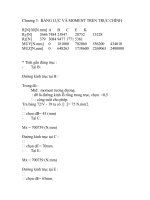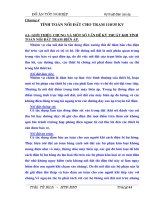Tài liệu Tính tóan động đất 14 ppt
Bạn đang xem bản rút gọn của tài liệu. Xem và tải ngay bản đầy đủ của tài liệu tại đây (141.01 KB, 12 trang )
FEDERAL EMERGENCY MANAGEMENT AGENCY FEMA 356 / November 2000
PRESTANDARD AND COMMENTARY FOR THE
SEISMIC REHABILITATION OF BUILDINGS
FEDERAL EMERGENCY MANAGEMENT AGENCY FEMA 356 / November 2000
PRESTANDARD AND COMMENTARY FOR THE
SEISMIC REHABILITATION OF BUILDINGS
NOTICE: This report was prepared under a cooperative agreement between the Federal Emergency Management
Agency and the American Society of Civil Engineers.
Any opinions, findings, conclusions, or recommendations expressed in this publication do not necessarily reflect the
views of the Federal Emergency Management Agency (FEMA) or the American Society of Civil Engineers (ASCE).
Additionally, neither FEMA, ASCE, nor any of their employees make any warranty, expressed or implied, nor
assumes any legal liability or responsibility for the accuracy, completeness, or usefulness of any information, prod-
uct, or process included in this publication. Users of information from this publication assume all liability arising
from such use.
For further information concerning this document or the activities of the ASCE, contact the American Society of
Civil Engineers, 1801 Alexander Bell Drive, Reston, Virginia, 20191, (703) 295-6000.
FEDERAL EMERGENCY MANAGEMENT AGENCY FEMA 356 / November 2000
PRESTANDARD AND COMMENTARY FOR THE
SEISMIC REHABILITATION OF BUILDINGS
Prepared by
AMERICAN SOCIETY OF CIVIL ENGINEERS
Reston, Virginia
Prepared for
FEDERAL EMERGENCY MANAGEMENT AGENCY
Washington, D.C.
November 2000
Federal Emergency Management Agency
Washington, D.C.
ASCE Standards Program and the Structural Engineering Institute
The Structural Engineering Institute (SEI) of the American Society of Civil Engineers (ASCE) was created in 1996 as a semi-
autonomous organization within ASCE to focus on serving the needs of the broad structural engineering community. The mis-
sion of SEI is to advance the profession of structural engineering by enhancing and sharing knowledge, supporting research, and
improving business and professional practices. SEI is comprised of three divisions: Technical Activities, Business and Profes-
sional Activities, and Codes and Standards Activities.
The standards activities of SEI operate under the umbrella of ASCE’s standards program. ASCE has over 125,000 members
worldwide. More than 7,000 of these members participate on over 500 technical committees, 44 of which are active Standards
Committees that have resulted in over 30 published standards, to date. In addition to individual participation, ASCE's standards
program actively encourages participation by representatives of affected organizations, thereby expanding the input into the stan-
dards developing process well beyond ASCE’s 125,000 members to ensure a high level of exposure and participation.
ASCE’s standards program, and hence SEI’s activities, are governed by the Rules for Standards Committees (referred to herein
as ASCE Rules). These Rules are reviewed and approved by the American National Standards Institute (ANSI), which accredits
ASCE as a standards developing organization (SDO). Membership and participation in ASCE's standards program is open to
both members and non-members of ASCE. Standards committees are required to publicize their activities through ASCE News
and to distribute meeting agendas at least 30 days in advance, to afford all interested parties the opportunity to participate. To fur-
ther extend beyond its membership, ASCE distributes press releases on new standards activities, and to announce when a stan-
dard progresses into the public ballot phase. ASCE’s Public Relations Department maintains a list of over 400 civil engineering
related publications, and it is common for 40 to 50 press releases to be distributed, thereby notifying and soliciting comments
from several hundred thousand individuals.
An ASCE standards committee must have a minimum of 12 members, though, current committees range in size from 12 to over
200 members. To join a standards committee, an application must be completed which describes the individual’s qualifications
and interest in the respective subject. However, acceptance of an applicant is not based solely on technical qualifications. During
the initial formation of a standards committee, membership is open to any interested party, provided they can demonstrate that
they are directly or indirectly affected by the activity.
As the committee begins its work to bring the standard into suitable condition for balloting, the committee also must ensure that
its membership is “balanced.” ASCE Rules define a balanced committee and require that members be classified into one of three
categories: Producer, Consumer, or General Interest. For standards of regulatory interest, a subclass of General Interest is estab-
lished for Regulators. Each of the three categories must compose from 20 to 40 percent of the total committee membership.
When the subclass of Regulators is established, they must compose 5 to 15 percent of the total membership.
Producers include representatives of manufacturers, distributors, developers, contractors and subcontractors, construction labor
organizations, associations of these groups, and professional consultants to these groups. Consumers include representatives of
owners, owner's organizations, designers, consultants retained by owners, testing laboratories retained by owners, and insurance
companies serving owners. General Interest members include researchers from private, state and federal organizations, represen-
tatives of public interest groups, representatives of consumer organizations, and representatives of standards and model code
organizations. Regulators include representatives of regulatory organizations at local, state, or federal levels of government.
Recognizing that committee members are volunteers whose time and travel budgets are limited, ASCE's Rules are designed to
allow members to fully participate in the work of the standards committee without attending committee meetings. Responding in
writing to letter ballots is a proven and effective means of participation.
ASCE’s ANSI accreditation ensures that all standards developed for the civil engineering profession that are intended to become
part of the laws which govern the profession have been developed through a process that is fully open, allows for the participa-
tion of all interested parties, and provides participants with due process. Standards resulting from this ANSI process are true
national voluntary consensus standards which serve and benefit the general public.
FEMA 356 Seismic Rehabilitation Prestandard v
Participants
Project Managers
Ugo Morelli, FEMA Project Officer
Thomas R. McLane, ASCE Project Manager
Project Team
Chris D. Poland, Principal Investigator
Jon A. Heintz, Author
Ashvin Shah, Author
Vicky Vance May, Author
Melvyn Green
Ronald O. Hamburger
William T. Holmes
Jack P. Moehle
Mike Mehrain
Lawrence D. Reaveley
Christopher Rojahn
Jim Rossberg
Daniel Shapiro
Diana Todd
Project Advisory Committee
John R. Baals, Chair
James Cagley
Edwin T. Dean
S.K. Ghosh
James O. Jirsa
Patrick J. Lama
Michael Valley
Richard A. Vognild
Eugene Zeller
Special Study Participants
Daniel P. Abrams
John M. Coil
Craig D. Comartin
W. Paul Grant
Darrick B. Hom
John Hooper
Brian Kehoe
Peter Somers
Desktop Publishing
Kris Ingle
vi Seismic Rehabilitation Prestandard FEMA 356
FEMA 356 Seismic Rehabilitation Prestandard vii
Foreword
The preparation of this prestandard was originally
undertaken with two principal and complementary
objectives. The first was to encourage the wider
application of the NEHRP Guidelines for the Seismic
Rehabilitation of Buildings, FEMA 273, by converting
it into mandatory language. Design professionals and
building officials thus would have at their disposal a
more specific reference document for making buildings
more resistant to earthquakes. This volume fully meets
this first objective.
The second objective was to provide a basis for a
nationally recognized, ANSI-approved standard that
would further help in disseminating and incorporating
the approaches and technology of the prestandard into
the mainstream of design and construction practices in
the United States. How successfully this volume
achieves the second objective will become apparent
with the passage of time, as this prestandard goes
through the balloting process of the American Society
of Civil Engineers.
Several additional related efforts were ongoing during
the development of this prestandard. A concerted effort
was made to gather any new information produced by
these endeavors. Topics varied considerably, but
typically covered approaches, methodologies, and
criteria. Whenever an analysis of the new information
disclosed significant advances or improvements in the
state-of-the-practice, they were included in this volume.
Thus, maintaining FEMA 273 as a living document—a
process to which FEMA is strongly committed—is
continuing.
FEMA and the Project Officer are deeply thankful to
the members of the Project Team and consultants, the
Project Advisory Committee, and the staff of the
American Society of Civil Engineers for their dedicated
efforts in completing this prestandard, which is a
significant addition to the bibliography on seismic
safety of existing buildings.
The Federal Emergency Management Agency
viii Seismic Rehabilitation Prestandard FEMA 356
FEMA 356 Seismic Rehabilitation Prestandard ix
Preface
The title of this document, FEMA 356 Prestandard and
Commentary for the Seismic Rehabilitation of
Buildings, incorporates a word that not all users may be
familiar with. That word—prestandard—has a special
meaning within the ASCE Standards Program in that it
signifies the document has been accepted for use as the
start of the formal standard development process,
however, the document has yet to be fully processed as
a voluntary consensus standard.
Users of this prestandard should be aware that the
ASCE Standards Committee on Seismic Rehabilitation
of Buildings is currently reviewing, discussing, and
potentially revising the document prior to issuing it as a
voluntary consensus standard. The Standards
Committee, with over 150 members, has voted to accept
this prestandard as the initial draft for their standard
which, upon completion, will be suitable for adoption
by building codes and inclusion in contracts. In early
2001, the Standards Committee will begin committee
balloting on this document to be followed by an open
public ballot period. The process the Standards
Committee will follow will be in accordance with the
ASCE Rules for Standards Committees. These rules
have been approved by the ASCE Board of Direction
and by the American National Standards Institute
(ANSI). A copy of these rules may be found in the
ASCE Official Register.
If you would like to participate in the formal standard
development process either as a member of the
Standards Committee or as part of the public ballot
process, please contact ASCE's Standards Coordinator,
Kim Brubaker, ASCE, 1801 Alexander Bell Drive,
Reston, VA 20191.
American Society of Civil Engineers
x Seismic Rehabilitation Prestandard FEMA 356









